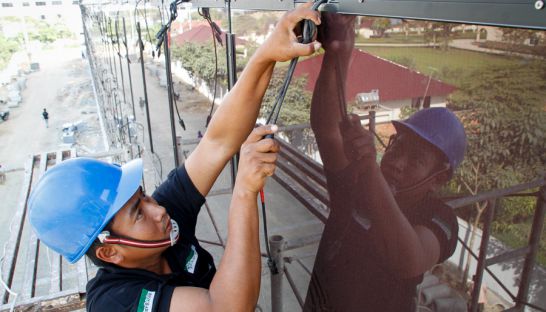SEZs starting to see the light of solar energy
SEZs starting to see the light of solar energy
Despite a precipitous drop in the start-up costs of solar energy, Cambodia’s biggest industrial parks are sticking to high-cost grid and fuel-generated electricity, claiming that when it comes to attracting foreign manufacturers, a stable power supply trumps a cheaper electricity bill.

However, a few special economic zones (SEZs) are optimistic about the future of solar and biomass energy in industrial settings, and are cautiously testing the waters with limited rollouts of “green” power-generating technologies.
One of these projects, announced earlier this month, is a $12.5 million deal inked between 7NG development group and solar-power supplier Kamworks to develop an 8-megawatt (MW) solar facility for 7NG’s Vihear Sour SEZ in Kandal province. The project aims to provide lower-cost electricity for factory workers living in the industrial park.
Closer to the capital, Phnom Penh SEZ inked a deal in February with Singaporean energy firm Cleantech Solar Corporation to deploy a photovoltaic (PV) solar system that will power the 357-hectare industrial zone’s administrative building. The 190 solar panels will generate about 7,500 kilowatt hours per month, enough to cover over half of the building’s electricity requirements.
Bob Anderson, deputy CEO of LCH Investment Group, the parent company of Phnom Penh SEZ, said he hoped the pilot program would encourage the industrial park’s factories to adopt PV solar technology.
“We intend to have this be an example for companies in the zone with the hope that others will follow,” Anderson said.
He went on to explain that with recent advancements, renewable technology – including biomass – provides SEZ customers with a “real choice, even without [government] subsidies.”
According to Jim Gramberg, CEO of Solar Partners Asia, a firm increasingly focused on outfitting industrial parks in Svay Rieng province, the price of PV solar panels has dropped substantially, and cost efficiency can now compete with coal and hydro power generation.
He said current Tier 1 PV solar technology – a ranking that makes projects eligible for international bank finance – has the capacity to power an entire industrial park made up of garment and light manufacturing factories. Moreover, the capital costs of switching to solar can be recovered quickly.
“The payback time on investment is usually within five to six years,” he said. “It reduces the electricity bill by about 50 per cent, and after 25 years of investment, a special economic zone can be fully reliant on its own source of energy.”
According to Gramberg, Solar Partners Asia has already inked more contracts with industrial firms in the first quarter of 2016 than over the course of the last two years. While he declined to give specifics on which two SEZs in Bavet have inked contracts, he said the company will soon begin construction on a 35 MW project near the Vietnam border.
Jayant Menon, lead economist of the Asian Development Bank’s Office for Regional Economic Integration, said the falling cost of renewable energy has made deployment viable, but Cambodia’s industrial sector is likely to remain reliant on grid-based energy for years to come.
“Given the very high cost of electricity in Cambodia at the moment, the options presented by alternative sources of energy, including solar, could be attractive,” he said. “But in the short run, these alternative sources of energy will only be able to complement, rather than completely substitute, traditional sources of energy.”
The $100 million Kerry Worldbridge SEZ will not include renewable technology when it debuts later this year, as the newest Cambodian SEZ needs to first shore up investment capital.
“We have focused on the fact that perhaps the more important issue is not necessarily cutting the high cost of electricity, but rather in ensuring a stable supply of electricity, which large non-garment manufacturers will require in order to locate in Cambodia,” said Charles Esterhoy, chief operations officer of the industrial park.
The reason why solar technology has been slow to take hold within industrial parks, he said, was due to a variety of factors, including high up-front capital costs, difficulties with ensuring long-term supply contracts and the lack of a developed regulatory framework.
However, he said it is “logical” that industrial parks would take the lead in developing reliable and sustainable energy supplies.
“An industrial park or SEZ has the advantage of and a higher concentration of users within one manageable area which leads to a generally more efficient generation and distribution system,” Esterhoy said.
Stephen Higgins, managing partner of investment firm Mekong Strategic Partners, said scale was a critical parameter, but he questions the viability of the recently announced solar projects given the lack of specifics and small investment capital.
That said, he added that “given the sharp decline in the cost of panels, and improving efficiency of panels, just about any industrial user with seven-day-a-week operations could get cheaper electricity from solar than what they are paying [the state electricity provider]”.
According to him, the overall advantage solar has from a price perspective is that it can be rolled out very quickly, compared to hydro or coal-fired plants that take years to develop.
“Unfortunately, the government has not been as supportive of solar as other governments in the region, but hopefully this will change as the economics of solar become so compelling that they have no other choice.”
For Gramberg, the crux of the problem lies with the lack of support from local lending institutions. He said while power plants can run into the millions of dollars, Cambodian investment authorities offer cost incentives for those built in SEZs, including tax exemptions and duty-free import of the components for construction.
However, “what is a very bad thing in Cambodia is that local banks have no clue about project investment costs, and the role that solar can play”.
Projects must instead look to funding from foreign banks, he said.













